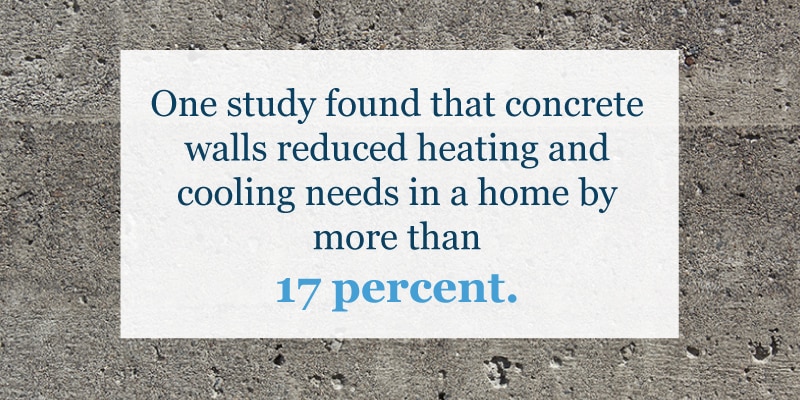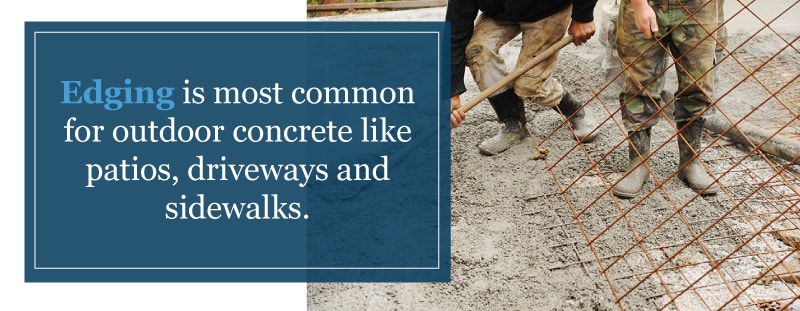How Concrete Is Made
Concrete is the most used building material in the world. We use more concrete than wood, aluminum, steel and plastic put together. It’s used in projects that range from dams to tunnels, from roadways to runways, driveways to patios, and increasingly in the home.
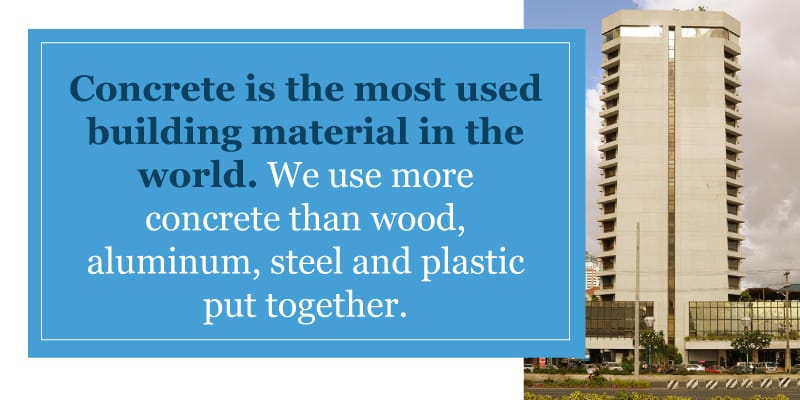
Although concrete is a popular building material, many people are unfamiliar with the production of concrete, as well as how concrete is delivered and poured. If you’re considering using concrete for a construction project, knowing more about how concrete production works can help you choose the right mixture for your project.
We’ve created this guide to the concrete production process, ordering and delivery. Read on to learn more about how concrete is produced and the easiest ordering and delivery process for concrete.
The Benefits of Using Concrete
We’re often asked how concrete compares to other building materials. Concrete offers many benefits: It’s easy to have concrete delivered to building sites. It’s also strong, fire resistant and durable. However, we think these five reasons are key to its popularity.
- It’s a Low-Maintenance Building Material
Unlike most other building materials, concrete needs very little maintenance. Its low-maintenance nature means it’s commonly used in dams, bridges and tunnels. It’s also made it an increasingly sought-after choice for homeowners. Concrete won’t rust like steel or attract mold like wood. When used for flooring, it also has lower maintenance needs than stone or porcelain.
- It’s Versatile and Easy to Shape
For most people, the biggest benefit to using concrete is its versatility. It’s easy to mold, stain, shape and paint. There are a variety of possible finishes and textures. This means concrete often looks like expensive, high-maintenance building materials. But unlike these materials, it doesn’t have the high price tag or maintenance.
- It’s an Affordable Choice
Compared to other building materials, concrete is a low-cost choice. It’s significantly less expensive than materials like steel, aluminum or wood. It’s usually produced locally, so there aren’t high transportation expenses. And its low-maintenance needs and long lifespan also contribute to its ongoing affordability.
- It’s an Environmentally Friendly Choice
Many people are surprised to find out that concrete is an environmentally friendly building material. It’s almost always produced locally, which reduces greenhouse gas emissions due to transportation. Concrete production creates fewer CO2 emissions than other building materials do. Its long lifespan means it doesn’t need to be replaced often, and it can be recycled to create new concrete when it does break down.
- It’s an Energy Efficient Building Material
Compared to other building products, concrete has a high thermal mass. This means it helps maintain steady air temperatures inside. One study found that concrete walls reduced heating and cooling needs in a home by more than 17 percent.
How Concrete Works
In the past, concrete was made primarily for house foundations and garage floors. Today concrete is being used in a wider variety of places than ever. Because it’s resistant to wind, water and fire damage, it’s an ideal material for homes. The fact that it’s strong and economical also makes it useful for residential construction.
Two other traits contribute to its popularity in residential construction. First, it’s made primarily from local materials, and often uses recycled components. Second, concrete is low maintenance. Although concrete needs some care, it’s less demanding than wood, tile or brick.
Some of the places concrete is used in and around the home include:
- Countertops
- Kitchen sinks
- Bathtubs
- Fireplace hearth or mantel
- Shower walls
- Driveways
- Sidewalks
- Patios
- Curbs
- Siding
- Floors
Using concrete for indoor floors is a popular new home trend. Concrete floors are chosen primarily for their durability. They’re also easy to clean and rarely need maintenance.
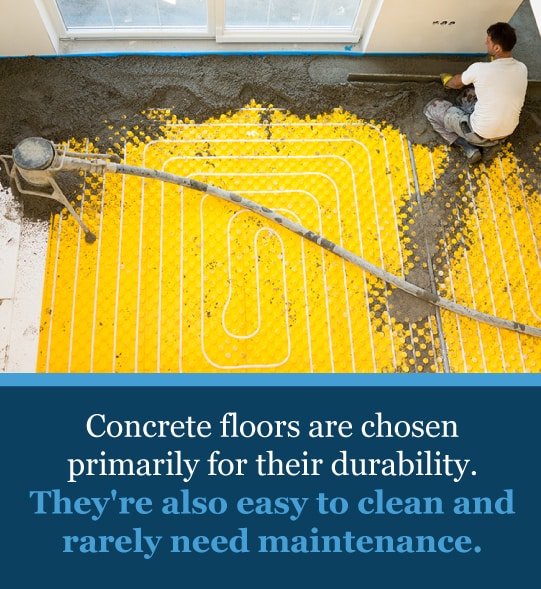
Concrete floors can have a wide variety of finishes and textures. This means each floor can have a one-of-a-kind appearance. When we pour concrete for a floor, we often use a fine aggregate mix and incorporate color. During the finishing process, the concrete can be scored, stamped or textured. This helps to create a tiled or textured look.
Concrete is a critical material outside of residential homes, too. It’s used in a wide variety of civil engineering, architecture and construction projects. The Hoover Dam and the Panama Canal were both made with concrete.
In industrial uses, concrete is an ideal material to use because of its durability. Fire and water resistance, plus a high tolerance for wind, make it ideal for a wide variety of building applications.
Some of the other uses for concrete include:
- Commercial and industrial buildings
- Office buildings
- Dams
- Breakwaters
- Roads
- Bridges
- Parking garages
- Airport runways
- Pipes and culverts
- Insulation
- Radiation shielding
The Concrete Production Process
You might be wondering, what materials makeup concrete? All concrete is made from a mixture of cement, aggregates and water. However, different types of concrete can have different percentages of water in it, or different types of aggregates. Read on to learn more about the primary ingredients and how concrete is made.
Cement Production
Cement is the binding agent in concrete. It’s a mixture of different elements, which include calcium, silicon, iron and aluminum. When water is added to it, a chemical reaction is activated. This causes the cement to harden, holding any aggregates in the mixture in place.
Portland cement is the most common type of cement. It’s used in most concrete projects around the world. The name doesn’t refer to a quarry or other source: It’s used for any limestone-based concrete that hardens when water is added. Before the water is added, Portland cement is a dry powder.
The primary ingredient in this cement is crushed limestone. This is mixed with sand or shale, and small amounts of other elements, to achieve the right chemical composition. Possible other ingredients include iron ore, clay, slate or blast furnace slag. These materials are all heated at very high temperatures, which often near 1600 C, before use as cement.
Aggregates
Aggregates are coarse materials like gravel, sand or crushed brick that are added to the cement and water. The cement binds to them, holding them in place. Although aggregates are often thought of as a filler, they’re actually a key component of concrete. Between 60 and 80 percent of concrete is made of aggregates.
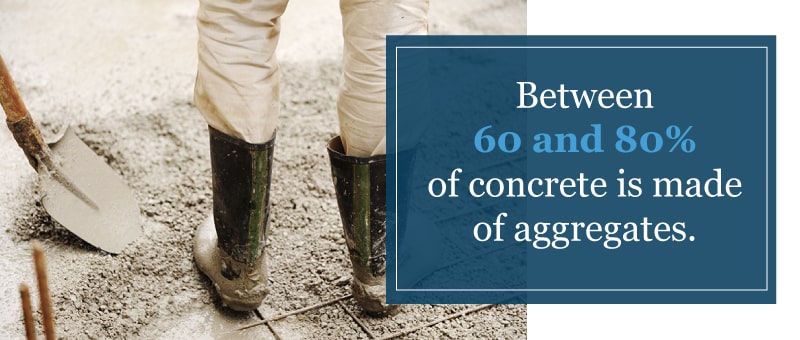
Other aggregates include:
- Crushed gravel
- Recycled cement
- Vermiculite
- Perlite
- Shale
- Slate
- Ceramic spheres
- Crushed limestone
- Steel or iron shot
- Steel or iron pellets
It’s important that aggregates used in concrete are clean, hard and relatively impervious to moisture. Before we add aggregates to the concrete mix, we clean them to remove any dust, dirt or other organic impurities.
We also sort aggregates by size. Using aggregates of roughly the same size helps ensure that the concrete is stable. It also helps us control the finish and affects how easy it is to work with the concrete before it hardens.
Water
Water makes up 14 to 18 percent of most concrete. It isn’t added until the concrete is almost ready to pour. That’s because water activates a chemical process called hydration, which eventually results in dried, or set, concrete. The heat that drying concrete gives off is called heat of hydration, and it’s a sign that the curing process is taking place.
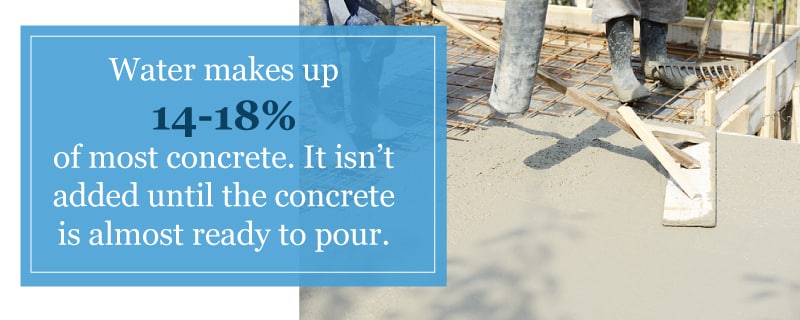
Determining the percentage of water to add to cement is a technical process. If too much water is added, the resulting concrete can be weak and susceptible to breakage. But if too little water is added, it will be difficult to shape and finish the concrete before it sets.
Cement, aggregates and concrete are the basic foundation of all concrete mixes. However, sometimes other elements are added to the mix. Some of these elements might include:
- Air Admixtures: Air admixtures help to create resilience in concrete. These admixtures are designed to help create microscopic air bubbles in the concrete. They’re a key component in keeping concrete from cracking during very cold weather.
- Plasticizers or Water Reducers: Plasticizers are sometimes added when concrete has a low water ratio. These are chemical additives that help make concrete more workable. When they’re used, plasticizers are usually just one to two percent of the final concrete mix.
Accelerating and Retarding Admixtures
These additives are used to extend or reduce the curing time for concrete. Accelerating admixtures are sometimes used in cold weather to help concrete set faster. This allows concrete finishing to begin sooner. Retarding admixtures, on the other hand, are used to slow down the hardening process during warm weather. This can help keep concrete workable for longer periods of time, and it is important when there’s a long finishing process.
Specialty Admixtures
Occasionally we use other additives for specific purposes. One of the most common is a corrosion inhibitor, which is used when the concrete could be exposed to corrosive agents. This is most commonly used on bridges and in parking garages, not in residential construction.
How Concrete Is Poured
Setting, pouring and finishing concrete is a complex process. Since concrete is usually poured and shaped on site, the site needs to be carefully prepared ahead of time. Here’s an example of what happens when we pour concrete — such as a foundation or patio — at a residential site.
How Concrete Is Made: Step by Step
Step 1: Preparing the Site
The first step in pouring concrete is to prepare the site. Any trees, shrubs or grass are removed. If we’re pouring a foundation or slab for a house, the entire area will be graded to make it level.
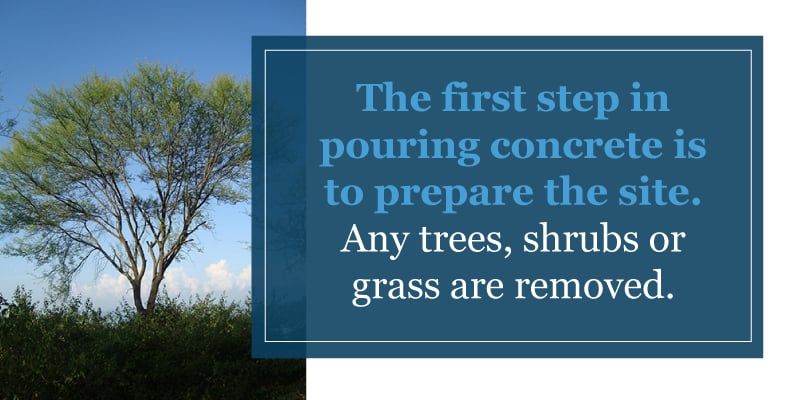
The first step is to place a sub-base of gravel over the site. The gravel will help the concrete set properly. It will also help to prevent the concrete from cracking from soil expansion due to water or cold.
Step 2: Constructing the Form
The next step is to construct a form for the concrete. This form will hold the concrete in place while it dries. Forms can be made from wood, metal or plastic. They range from simple squares just a few inches tall to complex shapes that are several meters high.
For residential construction like a slab, foundation or patio, a form is usually made from wood. 2×4 or 2×6 lumber is nailed together and removed once the concrete is dry. Because of the weight of concrete, most forms are braced to ensure the wood doesn’t bend once the concrete is poured. Throughout the building process, we check to ensure that the forms are level and straight.
Step 3: Pouring the Concrete
This is the first time you’ll be working with actual concrete. Sometimes it feels like preparing to pour concrete takes more time than the actual pouring. However, preparing the site and forms properly results in stronger, longer-lasting concrete.
Concrete is usually delivered in a ready-mix truck. These trucks have a revolving drum that mixes the concrete and keeps it from hardening before it’s poured.
It’s important to find a local supplier because concrete needs to be poured soon after it’s mixed. In general, concrete should be poured within 1.5 hours of mixing, or within 300 revolutions of the drum — whichever comes first.
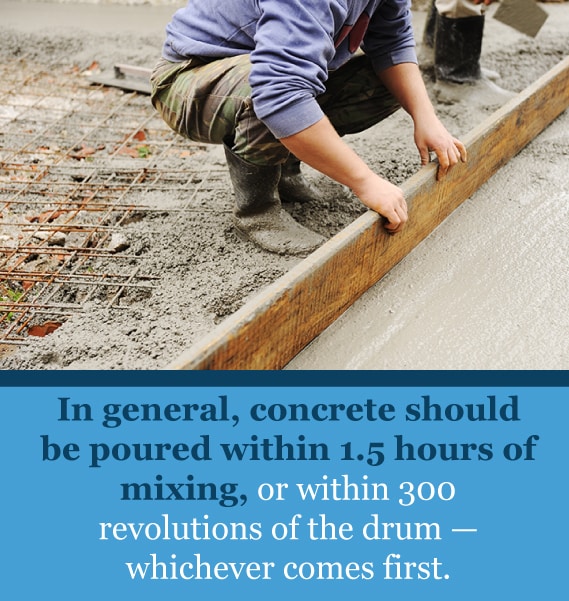
If the concrete mixer can pull up directly to the job site, the concrete is usually poured directly from the truck. If not, wheelbarrows or pumps will be used to fill the forms. We pour the concrete until it reaches the very top of the form.
During the concrete pouring process, the crew will spread the concrete with rakes, shovels and come-alongs. This helps to ensure that the concrete is spread evenly and prevents air pockets from forming.
Step 4: Early Finishing
Once the concrete is poured, we begin the early finishing process. During this phase, we use darbies and screeds to flatten and level the concrete. Any holes or large marks are filled and smoothed out.
During the early finishing process, it’s important not to overwork the concrete. Finer aggregates like sand usually rise to the surface during the early finishing process, which can help to create a smooth surface. However, overworking can cause too much sand and cement to rise to the surface. This weakens the integrity of the concrete and can cause it to crack under heavy weight.
Then we wait for surface water, or “bleed” water, to disappear. This water escapes from the concrete early in the setting process. It will be reabsorbed before the concrete dries. However, finishing the surface before the bleed water dries will result in weaker concrete.
Step 5: Floating and Troweling
By the time the bleed water disappears, the concrete is usually moderately hard. The concrete can still be shaped with tools, but it will hold its shape by this point. Now it’s time to float and trowel the surface.
Floats and trowels are used to smooth and harden the surface of the concrete. This process can be done by hand, or by using a mechanical float or trowel. Both processes involve pushing or pulling a metal surface over the concrete, which increases the surface on the pressure.
This causes the concrete to form a smooth, hard surface. Troweling is often done multiple times during the drying process to maximize the density of the concrete surface.
We also edge the concrete during this phase. Edging is most common for outdoor concrete-like patios, driveways and sidewalks. During edging, we bevel or round the edges of the concrete to reduce the chance of cracking during cold weather.
Step 6: Finishing the Concrete
Finishing is one of the last steps of the pouring process. This step gives the surface its final texture and appearance.
Broom finishes are the most common type of finish. Indoor or decorative concrete may go through other finishing techniques to create the desired texture and pattern. Broom finishes are done by dragging a broom through the surface of the concrete. This creates a slip-resistant finish. This is particularly common for residential foundations, when contractors will need to work on top of the foundation to build the rest of the house.
Other finishing techniques include:
- Rock salt finishes
- Exposed aggregate finishes
- Colors and paints
- Concrete stains
- Polishing
- Stamping
- Stenciling
These techniques can be used separately or in conjunction. Stamping and colors are often used together to mimic the look of stone, brick or tile.
Step 7: Curing the Concrete
The final step of pouring concrete is curing. This process begins as soon as the concrete is mixed, but can take several months to fully complete. The goal of curing is to maintain enough moisture for the hydration process to continue, which leads to stronger concrete.
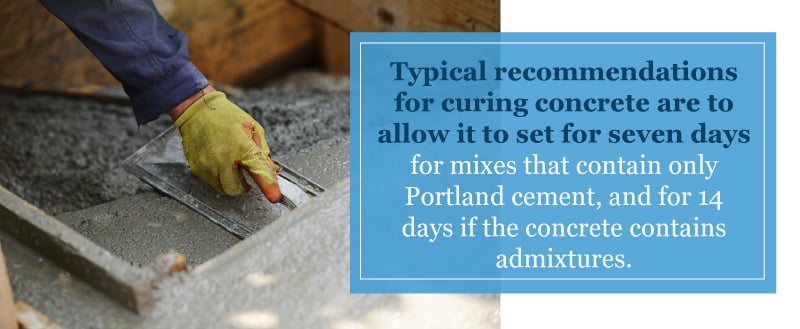
Typical recommendations for curing concrete are to allow it to set for seven days for mixes that contain only Portland cement, and for 14 days if the concrete contains admixtures. The specific length of time concrete needs to cure is affected by the outdoor temperature, the concrete mixture and the specific strength of the concrete.
During the curing process, it’s important to keep concrete within a set temperature range. This helps to prevent cracks from forming in the concrete, which can reduce its strength. Sometimes the surface of the concrete is immersed in water, or ponded, or covered with insulating blankets to maintain the correct temperature.
How to Order Concrete Online
It’s important to find a reliable local supplier for concrete. Ready-mix concrete begins to cure as soon as it’s mixed, so it’s best to find a supplier as close as possible.
When ordering, you’ll need to know a few important details:
- The specific concrete mix you’ll need
- Amount of concrete needed
- Date and time the concrete should be delivered
We can also help you determine how much concrete you need and whether the concrete mix is right for your job. If you’re taking on a new project, it can be a good idea to ask for advice on the concrete mix and any additives. Let us know what your goal is, and we can help you find the right concrete mix to make it happen.
You can also order concrete for delivery online. If you already know what mixture you’d like, and when you want it, ordering concrete online is a great way to get it delivered fast. If this is your first time ordering concrete for delivery online, keep these tips in mind to ensure a successful project.
- Concrete is ordered by the cubic yard. To figure out how many cubic yards you need, figure out the volume of the area in cubic feet, then divide by 27.
- Order a little more concrete than needed to cover spillage or uneven basis. A good rule of thumb is to add about five percent to your order.
- In cold climates, your concrete mix should include air entrainment of at least four percent. This helps keeps the concrete resilient during seasonal changes.
- Choose the right concrete mix for your job. Standard ready-mix is the most common type of concrete. There are also special forms like architectural, corrosion-resistant, self condensing and lightweight.
- Order ahead of time when possible. This is particularly important when you have a big job or need a specialty mix.
- Make sure your job site is ready-mix accessible. It’s important for the concrete mixer to be as close as possible to the job site.
From a single order for your home DIY project to a large order for industrial projects, our fleet of concrete mixers will get high-quality concrete to your job site quickly.
If you know already know what you need, you can order concrete online from Marstellar via our easy order form. And if you need assistance, we can help you find the right mixture for your project. If you’re looking for concrete in the Harrisburg, Pennsylvania area, contact us for assistance.


